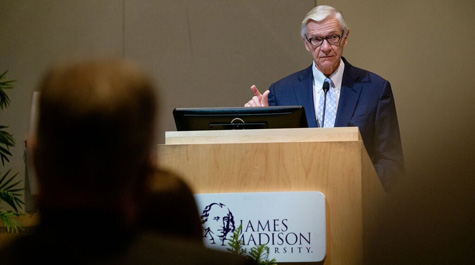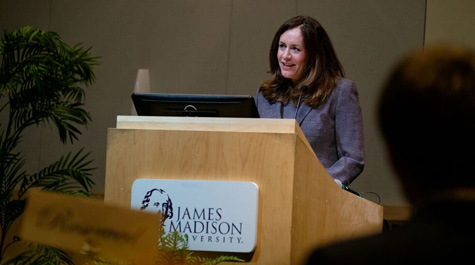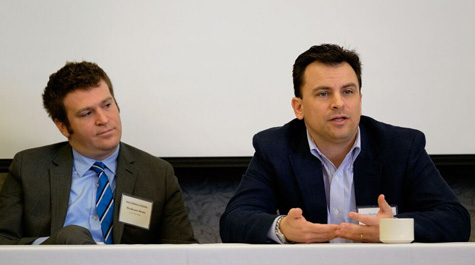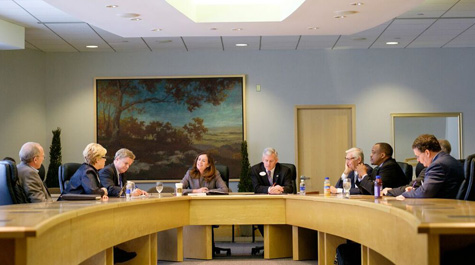College presidents declare commitment for a service year
The following article was originally published on the James Madison University website and has been modified for a William & Mary audience. - Ed.
“Service is a part of your DNA,” First Lady of Virginia Dorothy McAuliffe remarked as she welcomed guests to the President’s Summit for the Service Year at James Madison University on Feb. 9.
William & Mary President Taylor Reveley and other campus leaders participated in the event, which built upon the Virginia Governor’s Higher Education Presidents’ Summit on the Service Year held at W&M in October 2015.
{{youtube:medium:left|pP7INZ0a1kM, Virginia Governor's Higher Education Presidents' Summit on the Service Year}}
In reading aloud the mission statements of many of Virginia’s higher education institutions, McAuliffe noted that the majority sought to mold enlightened citizens who are engaged with the world. She then asserted that a service year would formalize the application of these ideals and visions.
The Service Year Alliance has three goals: create one million service year positions, incentivize young people to participate in service, and make national service a rite of passage and an expectation. Public service, they believe, will connect people to something bigger than themselves and develop true citizenship.
“Service has long been one of William & Mary’s defining characteristics, and I know that is true for many of the Commonwealth’s other colleges and universities,” said Reveley. “We had a very promising day of discussions at William & Mary in the fall, and it was good to see our momentum continue at JMU. The idea of a service year as a common commitment among young people has great potential, and we are very interested in seeing if flesh can be put on the bones of the concept.”
Virginia universities have been a dedicated partner in this movement and have an essential role to play in the creation of service opportunities and the incentivizing of service with academic credits and potential financial aid. The summit culminated with the signing of a compact formally declaring commitment to the service year by presidents and provosts from James Madison University, William & Mary, Averett University, Eastern Mennonite University and Blue Ridge Community College. Other college presidents will be invited to sign the compact.
The compact seeks to include public, private and community colleges and allows for a great deal of flexibility in the ways in which educational institutions use their student bodies, community partnerships and resources to construct a service year experience.
Because service is already so deeply embedded into higher education, the initiative also aims to employ advanced data collection techniques to audit existing service opportunities, identify thriving programs and measure progress towards shared goals.
Along with Reveley, other William & Mary representatives at the event included Drew Stelljes, assistant vice president for student affairs, and Karen Kennedy Schultz '75, a member of the Board of Visitors.
“The summit at James Madison allowed us to build on the ideas generated at the governor's summit at William & Mary,” said Stelljes. “As we continue to build momentum for the service year, we are working together to develop best practices for the role of higher education in this national movement. In the coming months we'll bring on new partners and colleges will be piloting their own service year programs. James Madison University, a national model for the engaged university, was an ideal host for the convening.”
At William & Mary, the service-year concept is embodied in the Community Engagement Fellowship Program, which allows graduates to spend a year in service to the Greater Williamsburg community. Four fellows are currently serving with the program.
“Just spend three minutes with the graduate fellows who serve in the Office of Community Engagement to be wowed by the benefits [of having service year positions at W&M],” said Schultz. “Each of them speaks of the growth that they have experienced with being in community, planning, organizing, writing, meeting new people, serving and helping others to serve. Each of our four graduates has his or her own area of engagement as well as inspiring countless students and community members to reflective service and greater understanding of the needs of the community.”
Service is “in the bones” of William & Mary, Schultz added, and the service year is the embodiment of what the university wants to see from incoming students and graduates.
“Look at the mission of W&M,” she said. “Service is embedded not only in the mission but the strategy, vision and goals of our schools and departments. Not only is it a good fit – it is W&M.”
As higher education leaders from across the state prepared to return to their respective campuses, Jonathan Alger of James Madison University shared his hope that all will work to “continually reflect on how service impacts our fundamental missions,” and envision the tremendous impact that a service year would have on the future of citizenship.
Virginia has also taken the lead as the first state in the nation to be designated an Employer of National Service. Dorothy McAuliffe commented that Gov. Terry McAuliffe would like to make Virginia a leader in the implementation of the service year, and develop a model for application that can be used by other states.
“The wrap-up and announcement of the next steps by First Lady Dorothy McAuliffe and JMU President Jonathan Alger served as a continuing energy and expectation for the questions, ‘Just how far can we go?’ and ‘Let’s get this done,’” said Schultz.
“The ‘let's get this done’ determination is inspiring,” she continued. “Our institutions of higher education are of a wide variety of size, scope, demographics, funding, and geography. The planning coming out of this summit is inspiring and visionary in that the implementation must be flexible enough to embrace the wide scope of mission statements and communities, yet robust and substantive enough to allow the crucial nature of service to be experienced in its myriad of possibilities.”
To learn more about the service year, visit: www.franklinproject.org.



















